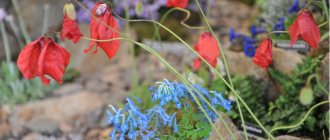The herbaceous annual, biennial and perennial plant soapwort, also called saponaria, is a member of the Cloveaceae family. According to information taken from various sources, this genus includes 15–40 species, but only 9 of them are cultivated. Under natural conditions, such a plant can be found in Eurasia. The name of this genus comes from the Latin word translated as “soap”, this is due to the fact that the root system of the plant has the ability to form foam due to the fact that it contains saponins.
Characteristics of soapwort
The plant has a highly developed root system, directly from which trunks or shoots extend vertically. In some species, the direction of their growth is horizontal. They are covered with greenish skin, in some varieties smooth and shiny, in others covered with villi, growing very often and covering the entire trunk. The height of the trunks in the most developed species reaches up to eighty centimeters.
The leaves are green and can have different shapes. Some take the shape of an oval, elongated along a horizontal axis, others resemble lancets, and there are other leaf shapes. The tops of some are sharp, while others have a smooth, rounded shape.
The flowers are pink, purple, rarely white, and consist of five wedge-shaped petals and a bunch of stamens protruding from the center. Collected in loose, numerous inflorescences containing up to a dozen flowers.
The fruit is an elongated capsule with tiny coal-colored seeds, of which there are a great many.
Botanical description
Soapwort flowers are rhizomatous plants with erect, prostrate or ascending, bare or pubescent stems up to 70-80 cm high. Whole oval, broadly lanceolate, linear-lanceolate or spatulate leaves of soapworts are arranged oppositely. Leaves may be tapered at the base or sessile, with sharp or blunt apices. White, purple or pink five-petaled flowers form loose corymbose-paniculate inflorescences. The fruit of representatives of the genus is a multi-seeded elongated capsule in which small, blunt-tubercular, almost black seeds ripen.
Varieties of soapwort
Of the many species of saponaria, only nine are grown artificially. The most commonly used soapwort species in gardening and their distinctive features are as follows.
Medicinal soapwort
It grows freely on almost the entire Eurasian continent, from the countries of Central Europe to the western part of Siberia. Individual plants reach a meter in height, the foliage has the shape of a pointed ellipse, elongated along the horizontal axis, the size of the leaves reaches twelve centimeters, three veins are clearly visible, dividing the leaf into three parts.
In inflorescences up to fifteen centimeters in size, there are up to a dozen double flowers on short stalks with a strong aroma, their petals are painted pink or white in various shades. The size of flowers can be up to two and a half centimeters.
This variety of bush has been grown since the end of the 17th century. Some varieties of this type of soapwort have flowers painted in a dark red color, while others have leaves that are not a single color, but, on the contrary, extremely variegated. There is a variety with bright white flowers that differ in shape from the usual type for this plant.
Lemperji
Grown and most commonly found in southern Europe. It is a forty centimeter bush with arched branches. The leaves are lancet-shaped, their color is even, green with a dark tint. Flowers with a classic Saponaria shape and color grow at the ends of the shoots and are collected in small inflorescences.
Yellow soapwort
A tiny perennial shrub, up to only one and a half centimeters tall, grows on the slopes of the Alpine mountains and in their meadow areas. The leaves of the plant resemble small straps in shape, slightly pointed at the top, and have an even green color. Light yellow flowers are collected in bunches of inflorescences of ten in each; their appearance and color can hardly be called beautiful.
Basilicofolia
In nature, it grows wild in the Alpine mountains, where it climbs to a height of up to two kilometers. The branches spread along the ground, blooms very profusely, covering large areas with a dense colored carpet. The leaves are narrow, have the shape of an elongated oval, and have an even green color. The flowers are very fragrant, shaped like a five-pointed star, with pink petals of the usual wedge shape. They are collected in small clusters of cup-shaped inflorescences located at the top of the branches. The branches, in turn, intertwine, forming a kind of soft covering over a large area.
The plant is quite adapted to winter conditions and even short-term frosts with a strong drop in temperature. During prolonged frosts, the soapwort dies, but soon enough it restores its population when the weather warms, as the seeds that fell into the ground last year ripen. There are varieties of this species with bright white flower petals.
Soddy
Wild Soapwort bushes grow in the Pyrenees Mountains and are found even at a level of two kilometers. The plant reaches fifteen centimeters in height, the leaves are lancet-shaped, the flower petals are oval-shaped and pink in color, the flowers are numerous. The stems mostly spread along the ground.
Olivana
A hybrid species with pink flowers that bloom profusely during the growing season. The shape of the plant resembles soft pillows, chaotically scattered on the surface of the earth. During the flowering period, the foliage is practically invisible under the carpet of flowers, but they are there, ellipse-shaped, even green in color.
general information
Soapwort (Saponaria) is a perennial shrub whose height does not exceed 15-20 cm. Rich green foliage can form a carpet on the lawn.
Soapwort basilicofolia
The flowers are small, no more than 1-1.5 cm in diameter, but there are a lot of them. The flowers are tubular, collected in inflorescences of 10-15 pieces at the top of the shoot, or solitary, depending on the variety. The plant is quite unpretentious, frost and moisture resistant.
The flower got its name from the fact that the roots can foam in water. Thanks to the saponin substance contained in the roots, this plant can be used to produce medicines, household detergents, and is also used in cooking.
Medicines that are made from this plant include medications that help in the treatment and prevention of the respiratory tract and diseased joints. Also, based on this medicinal plant, preparations and decoctions are made that can improve the cleanliness of the skin.
For reference: in Russia the most common medicinal and basilico-leaved varieties of soapwort.
Planting saponaria in open ground
When choosing a place to plant a plant, you should take into account the fertility of the soil, as well as its drainage properties. If the soil is not fertile enough, it will need to be fertilized frequently. If it is too dense, its drainage should be improved. Standing water remaining at the root of saponaria for a long time can lead to the death of the plant from rotting of the root system.
In order to prevent this, at the site where the bushes are planted, you should dig up the soil, mixing it with sand and adding crushed stone or expanded clay. In case of heavy rains, this measure may not help, and the water will still stagnate. Therefore, in such cases, the bed with planted soapworts is protected from the abundance of moisture with a film stretched over the arcs.
To prevent the appearance of weeds in the place chosen for growing saponaria, after sowing seeds or planting sprouts, it can be covered under a layer of fine crushed stone, or a small pebble stone can be placed there. In addition to protecting against weeds, this technique will make the area more decorative.
Fertilizer and feeding of soapwort. What diseases and pests plague the crop?
Saponaria grows well without fertilization. The exception is clay soil, to which you can add a little humus mixed with sand in the spring. At the same time, some gardeners add phosphorus fertilizers to the soil. If desired, you can feed the soapwort with any mineral mixtures a couple of times during the season.
Saponaria is considered resistant to diseases and pest attacks. Still, if you notice spots on the leaves, spray them with Bordeaux mixture (1%). An alternative is Fundazol. Among insects, the cutworm can settle on soapwort. It is best to control gray caterpillars or dark brown moths manually by collecting the pests regularly.
Growing soapwort and caring for it is a simple and rewarding task. After all, for your attention and care, saponaria will delight you with delicate and fragrant flowering.
Rules of care
Rules for caring for a plant in a garden bed include regular weeding, timely watering, fertilizing at the right time and regular pruning. Also, if the climate is quite harsh and the winters are frosty, the bushes need to be prepared in time for the winter period.
Watering
Watering should be moderate; during periods with frequent rains it is not necessary at all. In this case, you should carefully ensure that there is no stagnation of water in the garden bed.
Trimming
Pruning involves regularly removing faded flowers and leaves. This will prolong the flowering period and prevent the spontaneous fall of seeds formed at the end of flowering, from which new soapworts grow uncontrollably.
Top dressing
Feeding is done twice per season. Organic fertilizers are not used. In early spring, after the snow melts, mineral fertilizers containing phosphorus and potassium are applied. This procedure is repeated before the start of the growing season at the beginning of the summer months. Mineral fertilizers containing nitrogen cannot be used. If the planting site is fertile enough, saponaria will grow well without any feeding.
Preparing for winter
Preparation for winter begins with the onset of autumn frosts. The branches of the plant should be shortened by a third. In representatives of the species medicinal saponaria and lemperdzhi, the shoots are cut off at the root collar. After pruning, the bed with plants is covered with spruce branches or other suitable material. When snow falls, it is also used for additional insulation of beds.
The soil
Any soil will do, but it is better to choose one that is neutral in acidity, fairly fertile and with good drainage.
What plants does it go with?
Soapwort combines with many perennial and annual plants. To create beautiful compositions, you should consider the height of the flowers:
- Tall species and varieties are combined with fern, aconite, ornamental grasses, dahlias, phlox, and asparagus. Looks good together with roses and peonies (they are placed in the background).
- Low-growing ones look good together with bluebell, sage, iris, and non-flowering herbs.
- Groundcovers are planted in open ground in combination with edelweiss, saxifrage, iberis, and yakolka.
When selecting plants, you should take into account the features of caring for them.
Transplantation and propagation
A soapwort shrub can grow in the same place without replanting for quite a long time, about eight years. But, after this time, it must be moved to another prepared and fertile bed to rejuvenate the crop.
This is done by dividing the plant: in the spring, soapwort bushes are dug up extremely carefully so as not to damage the roots and divided into parts, which are planted in a new place. There the plant will develop intensively for the next eight years.
Saponaria reproduces by planting seedlings and sowing seeds. Of these two methods, the first is preferable.
Propagation by seeds
Propagation by seeds can be done by sowing them directly into the ground. This operation is performed at the end of autumn before the onset of the first frost. In this case, the planting site is carefully insulated for the winter and the plants sprout in early spring.
You can also sow seeds in the ground in the spring, to a depth of three centimeters, having previously prepared the soil, fertilized it and made a good drainage system. By mid-summer the plant will begin to bloom.
Growing seedlings
However, the method of growing saponaria from seedlings is more often used; it is more reliable and does not require much labor. In the middle of spring, the seeds are placed in seedling pots filled with a damp earthen mixture for flowers.
After this, they are sprinkled with sand, watered by spraying and covered with glass or film. Pots with seeds planted in them are placed in a room with good diffuse lighting and a temperature regime of around twenty degrees Celsius.
After the sprouts appear, the glass is removed and germination begins. The sprouts should be protected from the sun; drafts should not occur; periodic watering and careful loosening of the soil are required. Two weeks before planting the sprouts in the garden, they are hardened by placing the pots with them in the air, increasing the time they spend there.
At the end of the second week of hardening, the seedlings should be outdoors for 24 hours. At the same time, you need to reliably protect it from adverse weather conditions.
After the threat of night frosts in spring has passed and the soil has warmed up well enough, the seedlings are planted in the ground. This period begins in the central zone of our country at the end of May.
When planting young shoots, there should be a distance of at least thirty centimeters between them. After planting, the planted plants are carefully watered. By mid-summer, the seedlings will have already developed and begun to bloom.
With precise and timely observance of these simple rules for caring for saponaria, it will soon cover the entire area allocated to it with a lush carpet.
Growing conditions
Saponaria is an unpretentious plant; it can grow in almost any soil. The main thing is that they meet the following requirements:
- pH value not lower than 7 units;
- good drainage;
- moderate nutritional value;
- constant moderate humidity.
Attention! The soapwort can survive a short drought without any problems, but in low-lying areas with stagnant water it will die very quickly.
Soapwort in the garden (photo)
Saponaria also prefers sunny areas, but it also develops and blooms well in partial shade.
Soapwort is a winter-hardy plant and under normal conditions it overwinters without any problems.
But if there is a frosty and snowless winter, then it is better to cover it with a layer of spruce branches or straw.
When favorable conditions are created, soapwort grows very quickly and sometimes forms quite large clumps.
This plant can grow in one place for up to 8 years without any problems. You can use it to create chic borders, but soapwort bushes look especially impressive on rocky soil.
Herpes, herpes zoster
Add 2 tbsp to 500 ml of boiling water. soap root. Boil for 5 minutes and let steep for 60 minutes. Strain the infusion and wash the rash with it several times a day. If necessary, you can apply a compress.
Bloating, nausea, gallstones
To prepare a decoction, it is recommended to make a collection of: 10 g of St. John's wort, 5 g of soapwort roots, 3 g of celandine. Stir and add 1 tbsp. mixture in 1 glass of hot water. Leave for 30 minutes. Drink the resulting drink throughout the day, but no more than 3 glasses per day.
Furunculosis
Prepare an infusion consisting of an infusion consisting of 240 ml of hot water and 1 tsp. crushed plant roots. Cover the container and leave for 4 hours. Take 2 tbsp. drink after meals 3 times a day.
Contraindications
The use of products based on medicinal raw materials requires consultation with a specialist. It is not recommended to use soapwort drugs if you are prone to allergic reactions. To avoid unpleasant consequences, you must follow the specified dosages and proportions when preparing dosage forms.
The use of decoctions, infusions and teas is contraindicated in the following cases:
- pregnancy;
- breast-feeding;
- childhood.
Ignoring contraindications can lead to the following side effects:
- epigastric pain;
- stool liquefaction;
- vomit;
- nausea.
Attention! A sweet-burning taste may indicate intoxication. An alarming sign is the characteristic sensation of mucus present in the mouth.











